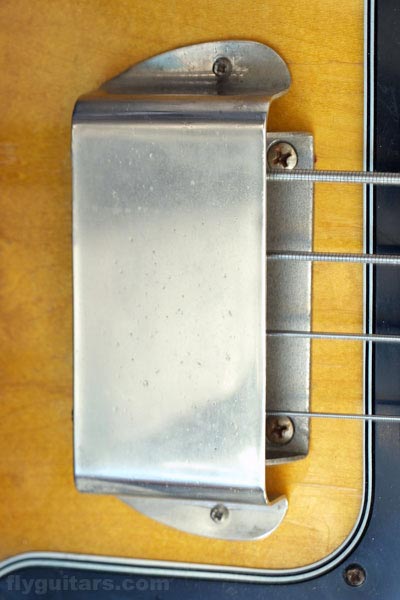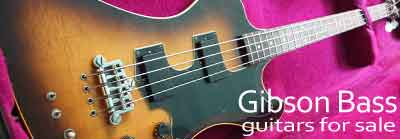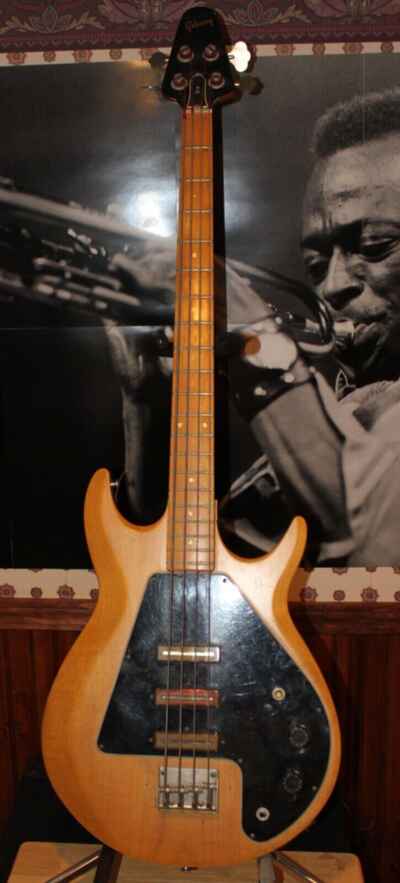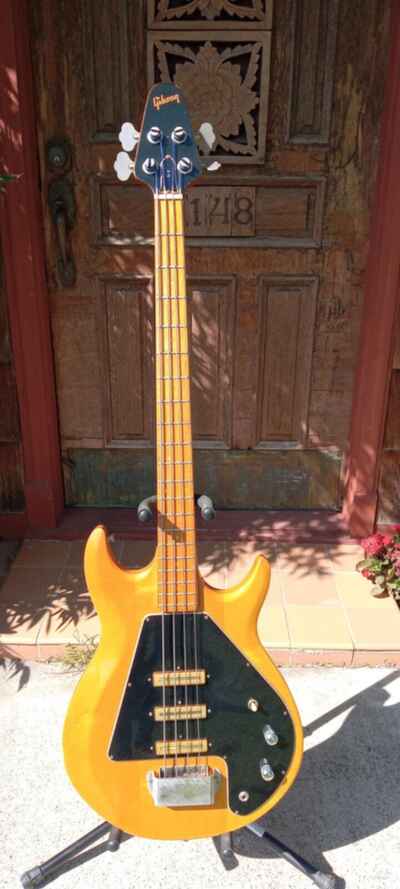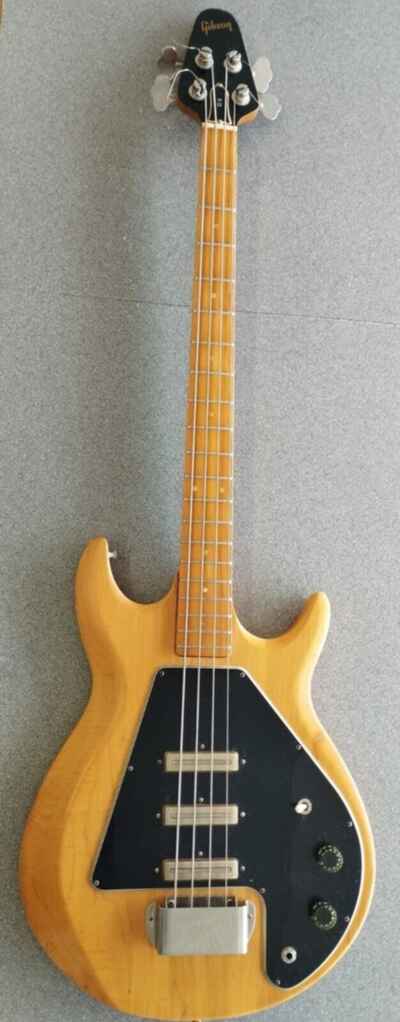The Gibson G-3 bass was produced from 1975 initially at the Gibson Kalamazoo plant, Michigan, USA. 1025 G-3 basses were shipped in 1978 with just 70 having a sunburst finish. Most had a natural (see a 1976 Natural G-3 bass), or ebony finish. 1976 was the peak year (see G-3 shipping figures). The electronics were designed by Bill Lawrence, who had already worked on the Ripper and Grabber basses.
No major changes were made to the bass' design over it's decade of production, but there were small cosmetic modifications. The black pickup covers, were first introduced in mid 1978, and this is one of the first examples to have been fitted with them. Older G-3 basses had clear pickup covers, through which the pickup windings and magnet were visible - see a 1976 G-3.
The G-3 was closely related to the Grabber, sharing the same basic construction, and some hardware. Both were long (34 1/2") scale basses, fitted with the Grabber bridge. This bridge is not suitable for direct stringing, strings enter the body from the back, and pass through it; this does require the use of extra-long scale strings.
1978 Gibson G-3 Bass specifications
Model: Gibson G-3
Year: 1978
Pickups: Three
G-3 single coil pickups, wired in a humbucking configuration
Scale: 34 1/2"
Body: Three piece maple body, Tobacco Sunburst finish
Neck: Three piece bolt-on maple neck. Maple fingerboard. Adjustable truss rod. 20 frets. Width at nut 1 5/8"
Weight: 4.4 kg
1978 US zone 1 price for the G-3 in tobacco sunburst finish was $509 in the January 1978 price lists, dropping to $499 in May. A total of 1025 G-3 basses were shipped in 1978, with the vast majority in Natural finish; only 40 instruments were shipped in Tobacco Sunburst finish as seen here.
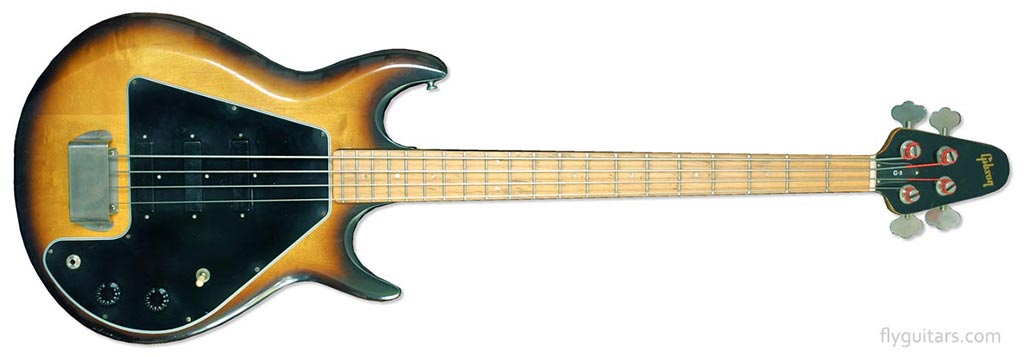
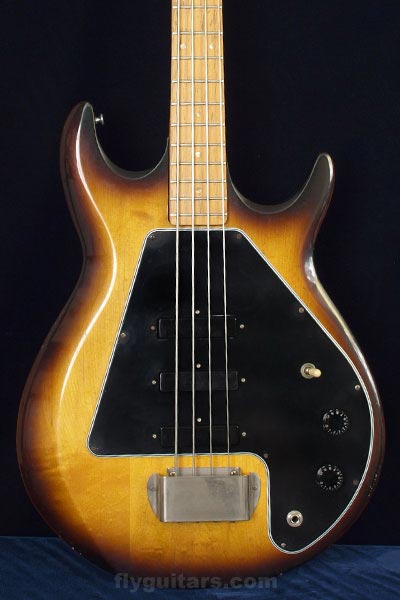
The G-3 was shipped with a maple or alder body; this one clearly is 3-piece maple, with just a small amount of figuring visible in places. Maple is one of the heavier woods used in guitar construction, and this bass weighs in at 4.4kg.
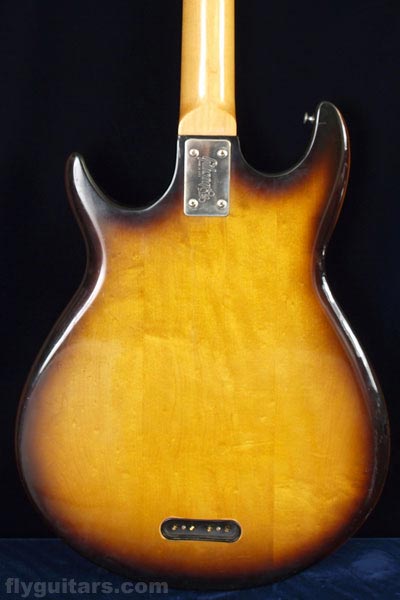
The sunburst finish employed on this 1978
G-3 bass goes from dark brown, through a mid reddish-brown and to the translucent yellow showing the typical grain patterns of maple. The G-3 can only be strung through the body, strings entering through holes in the black plate near the bottom end of this bass.
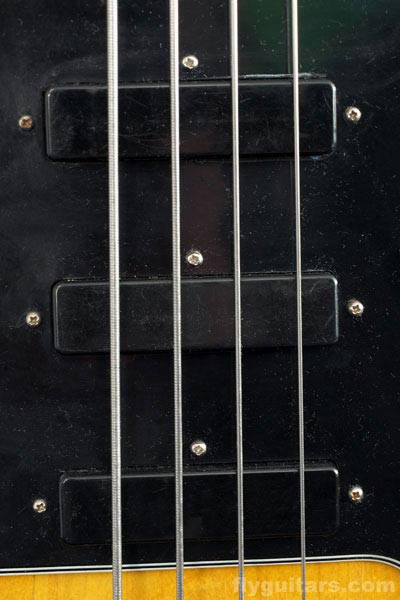
The pickups are mounted onto the scratchplate, each held in place by three screws, also used to adjust the pickup height, and angle. The black covers indicate a later G-3; prior to mid 1978 the covers were translucent plastic, showing the red coil windings and Alnico core. (See
translucent G-3 pickups on a '76 G-3).
The pickups, although single coil units, were combined in a similar manor to the two coils in a humbucker. There were three possible configurations: either neck and middle pickups, and bridge and middle pickups, or all three pickups active at once, which Gibson called the "buck-and-a-half" setting. See also
G-3 circuit photos / schematic.
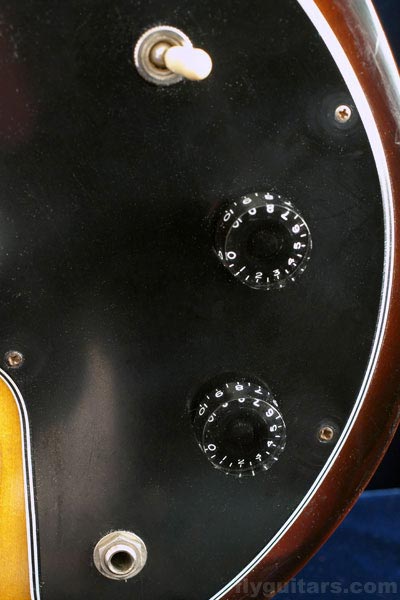
The G-3 (or Grabber 3) is so named because it is basically a
Grabber with three pickups. The pickup switch selects 2 or 3 pickup combinations, as in a three-pickup
Les Paul Custom: that is neck and middle pickups, neck and bridge, or all three. Quite differently from the Les Paul, these pickups are all single coil units, yet are wired together as humbuckers with each pickup representing a different coil of the humbucker, cancelling noise.
The controls are fitted with the typical Gibson speed knobs used throughout the mid-late 1970s; one volume and one tone control.
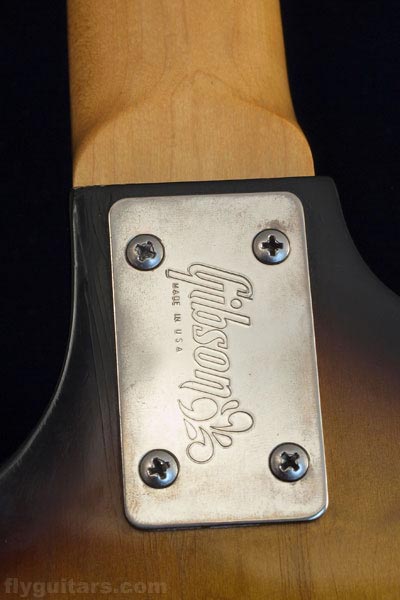
The
G-3 neck is attached to the body via 4 screws at the neckplate showing the mid seventies style Gibson logo, and MADE IN USA.
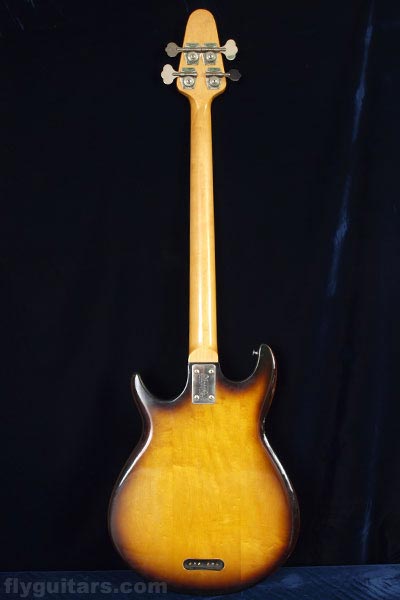
The Grabber and G-3 were Gibson's first bolt-on neck basses. Combined with being built of maple instead of mahogany and rosewood, and with Bill Lawrence's innovative electronics, these offered completely new sounding basses for Gibson.
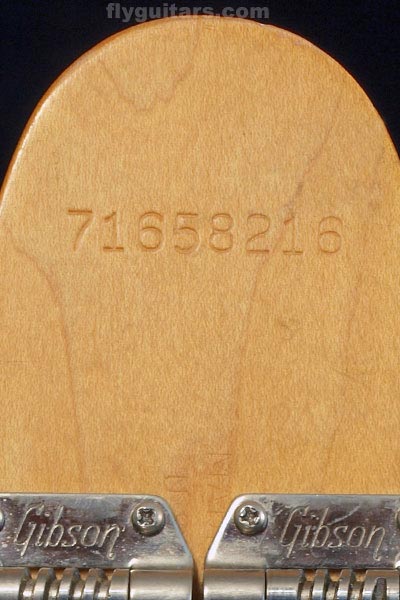
The eight digit serial number system was introduced to Gibson guitars in 1977. As usual it was positioned on the top-back of the headstock. Unlike serial numbers on older guitars, several facts can be gleaned from this number; approximate production date being the most useful. The serial number on this
G-3,
71658216 tells us that this bass was stamped on the 14th June 19
78 (day
165), at the Gibson Kalamazoo plant, and was the
216th instrument stamped that day. Compare this to a
1975 Grabber with a six digit stamped serial number, and a
1976 Grabber 3 with a eight digit decal serial number, in which the first two digits give the year. Read more about
Gibson serial numbers in general.
The words MADE IN USA are also stamped to the reverse of the headstock, although in this case they are not easy to spot; they run perpendicularly to the serial number, and are partially covered by the tuning keys, towards the bottom of this image.
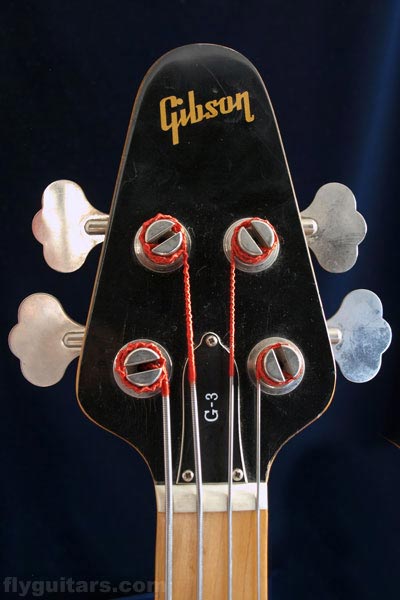
The headstock of this G-3 is quite typical; Flying-V style, finished in black with the gold silk-screened Gibson logo and
Schaller BM tuning keys.
As is the case for all G-3 basses, the truss rod cover has the G-3 model designation, although only a few (usually 1978) G-3s had the flat bottom edge and three screws attaching it to the headstock. The vast majority of earlier and later G-3 truss rods were the traditional Gibson 2-screw bell-style, although this style was more widely used on G-1 Grabber. Compare this to a
1976 G-3 with a 2-screw cover.
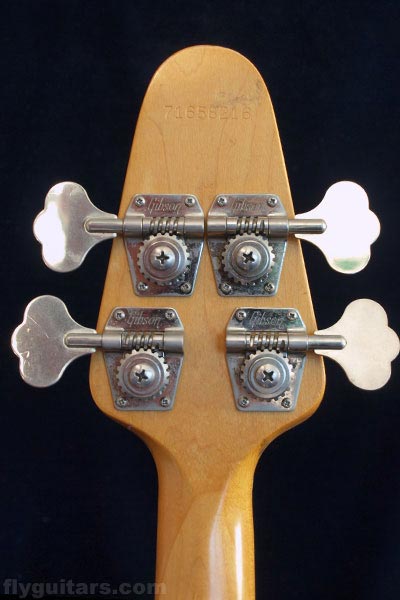
Gibson G-3 bass reverse headstock detail showing serial number and Schaller BM tuners, each marked Gibson. Note the scarf joint where the headstock attaches to the neck. All G-3 bass necks are constructed of maple, though later ones were actually a three-piece laminate and often very highly flamed.
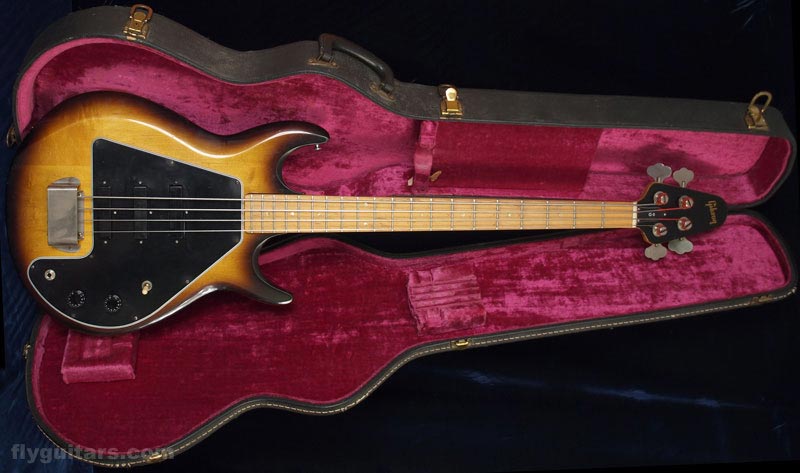
1978 Gibson G-3 bass with purple/pink lined hard case
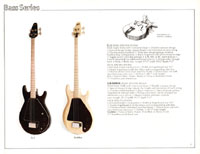
Gibson G-3 bass for sale
Flyguitars.com is funded by its visitors. When you buy through links on our site we may earn an affiliate commission. For more info see
terms and conditions.
East Amherst, New York, 140**, UNITED STATES OF AMERICA
$3200
This vintage Gibson G3 Grabber Electric Bass is a rare gem for any musician. With a beautiful blond body made of alder and maple, this right-handed bass guitar features a rosewood, ebony, and maple fretboard, making it a dream come true for any player. The 4-string configuration and vintage series add to its uniqueness, making it a must-have for any collector. This bass guitar comes with its original hard Gibson case, making it easy to transport and store. Perfect for any musician or collector, ...
more
Fort Worth, Texas, 761**, UNITED STATES OF AMERICA
$2995
All original vintage 1977 Gibson Grabber G-3 bass guitar. Nice bright with depth tone. A lot of presence. G-3's were the Cadillac Grabber of it's day. This one is in remarkably good condition, especially for it's age. Kiss, Grand Funk, Nirvana, Green Day, The Who, etc BODY: Sculpted maple NECK: Maple with maple fingerboard and MOP dots BRIDGE: Original string through the body bridge, so the strings are really throwing a signal. Surprisingly still has the original bridge cover (that's rare for ...
more
Porth, CF39***, UNITED KINGDOM
£2557
Rarely available this U S.made Gibson 'Grabber' G-3 is a superbly made qualiiy instrument with a unique sound dating from the mid 1970's. Excellent condition given its age and in perfect working order
Serial numbner: 06167800
3 position switch controlling the 3 pick-ups with volume and tone controls
This instrument was purchased by me in Cardiff south Wales in early 1982....
more





